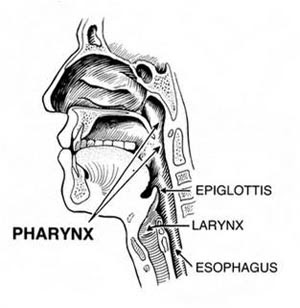Mouth
- The mouth begins the process of carbohydrate digestion through the action of saliva. Salivary amylase, the enzyme found in saliva, starts the chemical digestion of starch, converting it from a polsaccharide to the disaccharide maltose.
- The wall of the stomach is lined with millions of gastric glands, which together secrete 400-800mL of gastric juice at each meal. Three kinds of cells are found in the gastric glands:
- Parietal Cells - secrete hydrochloric acid and intrinsic factor (aids in absorption of vitamin B12 by the large intestine)
- Cheif Cells - secrete pepsinogen
- Mucous Secreting Cells - secrete mucous
- A very important constituent of gastric juices is the substance pepsinogen. Pepsinogen is not an enzyme but a forerunner of the enzyme pepsin. The hydrocholoric acid secreted increases the acidity of the stomach contents to a pH of 2 or lower. At this pH, pepsinogen is converted to pepsin, an active enzyme which begins the chemical digestion of proteins into peptides.
- Salivary amylase functions best at pH 6 or 7. Therefore, it becomes inactive when it reaches the stomch, and consequently, digestion of starch does not take place there.
- The mucous coats the cells lining the stomach and protects them from the digestive action of enzyme pepsin.
- Final digestion of proteins and carbohydrates must occur, and fats have not yet been digested. Villi have cells that produce intestinal enzymes which complete the digestion of peptides and sugars.
- The upper part, the duodenum, is the most acitve in digestion. Secretions from the liver and pancreas are used for digestion in the duodenum. Epithelial cells of the duodenum secrete a watery mucous which acts to protect its lining from pepsin and HCI. The pancreas secreted digestive enzymes and stomach acid neutralizing sodium bicarbonate. The sodium bicarbonate neutralizes the acidic chyme, allowing the enzymes in the small intestine to function and protect the intestinal wall.
- The liver produces bile, which is stored in the gall bladder before entering the bile duct into the duodenum. Bile contains cholesterol, phospholipids, bilirubin, and a mix of salts. Bile salts emulsify - breaking them down into progressivly smaller fat globules until they can be acted upon by fat digesting enzymes. They also aid in neutralizing the chyme from the stomach.
- The chemical digestion that begins in the small intestine is a result of pancreatic secretions. Starch and glycogen are broken down into maltose through the action of pancreatic amylase. Proteases continue the breakdown of protein that began in the stomach and form small peptide fragments and some amino acids. Lipase break down fats into fatty acids and glycerol.
- Finally, the villi in the small intestine itself, release enzymes which complete the digestive process. Maltease, lactose and sucrase are three carbohydarate digesting enzymes which break down the maltose, sucrose and lactose into monosaccaraids.
- Lactose intolerence results from a lack of the enzyme lactose. Peptidase breaks down peptides into amino acids and nuclease breaks down nucleic acids into sugars and nitrogen bases.









